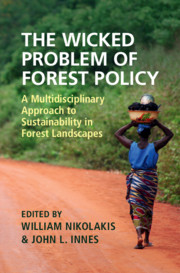 The Wicked Problem of Forest Policy
The Wicked Problem of Forest Policy Book contents
- The Wicked Problem of Forest Policy
- The Wicked Problem of Forest Policy
- Copyright page
- Contents
- Contributors
- 1 The Wicked Problem of Forest Policy
- Part I Wicked Problems and Policies
- 2 Why Forests Matter?
- 3 Forest Certification and Forest Use
- 4 REDD+ Meets Local Realities
- 5 Have Payments for Ecosystem Services Delivered for the Rural Poor?
- 6 Tackling Gender Inequality through Forest-Related Policies and Programmes
- 7 Forestry Crimes and Our Planet
- 8 Forest Bioeconomy Development
- Part II Tools to Address Wicked Problems
- Index
- References
7 - Forestry Crimes and Our Planet
A Review
from Part I - Wicked Problems and Policies
Published online by Cambridge University Press: 24 July 2020
- The Wicked Problem of Forest Policy
- The Wicked Problem of Forest Policy
- Copyright page
- Contents
- Contributors
- 1 The Wicked Problem of Forest Policy
- Part I Wicked Problems and Policies
- 2 Why Forests Matter?
- 3 Forest Certification and Forest Use
- 4 REDD+ Meets Local Realities
- 5 Have Payments for Ecosystem Services Delivered for the Rural Poor?
- 6 Tackling Gender Inequality through Forest-Related Policies and Programmes
- 7 Forestry Crimes and Our Planet
- 8 Forest Bioeconomy Development
- Part II Tools to Address Wicked Problems
- Index
- References
Summary
Forestry crimes include illegal logging, which is a contributing factor to deforestation across the globe. An estimated 189 to 565 million cubic metres of timber are cut illegally in some form. Forestry crimes are estimated by INTERPOL and the United Nations to be valued at US$51–152 billion annually. Much of this harvest is used for wood fuel and charcoal, and the proceeds from illegal logging are sometimes used to fund terrorist groups. Globally, (excluding illegal logging for wood fuel and charcoal). To date, the only effective interventions have been the efforts by the Brazilian government using targeted law enforcement efforts to combat illegal logging, the result of which was a 76% reduction in deforestation.
- Type
- Chapter
- Information
- The Wicked Problem of Forest PolicyA Multidisciplinary Approach to Sustainability in Forest Landscapes, pp. 197 - 230Publisher: Cambridge University PressPrint publication year: 2020
References
- 1
- Cited by
